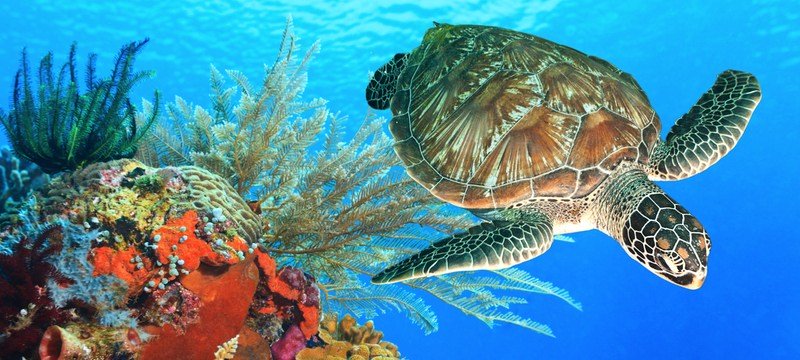Since 2000, May 23 – World Turtle Day, is sponsored yearly by the nonprofit corporation American Tortoise Rescue. The idea is to bring attention to, and increase knowledge of and respect for, turtles and tortoises and encourage human action to help them survive and thrive. This day is celebrated worldwide in a variety ways, dressing up as turtles or wearing green summer dresses, saving turtles caught on highways, or research activities.
So why not know a little bit more about this gentle animals, one of the world’s oldest creatures?
Do you know the difference between turtles and tortoises? Turtles live mainly in water. Tortoises live mainly on land. Now, let’s learn more interesting facts about turtles!
1.
Turtles are reptiles and characterized as ectotherms, commonly known as cold-blooded.
2.
Turtles are one of the oldest reptile groups and a more ancient group than lizards, snakes or crocodiles. The earliest known turtles date from 220 million years ago!
3.
Turtles live on every continent except Antarctica.
4.
There are about 330 species of turtles worldwide.
5.
Many of turtles species have an average lifespan of 100 years or more. The world’s oldest captive animal died in 2006 in Brisbane, at the estimated age of 176 years. It was a female giant Galapagos tortoise named Harriet, and was the last living witness to Charles Darwin’s most famous voyage.
6.
Turtles have a hard shell that protects them like a shield, this upper shell is called the carapace. The lower shell that encases the belly is called the plastron.
7.
The inner layer of a turtle’s shell is made up of about 60 different bones all connected together.
8.
Some turtle species have the capability to hide their heads under their shells when attacked by predators.
9.
Tortoises have high, heavy and domed shells that offer protection from the snapping jaws of terrestrial predators.
10.
The aquatic turtles’s shells are more flatter, a more aerodynamically shaped. Their have lighter shells that help them avoid sinking in water and swim faster with more agility. These lighter shells have large spaces called fontanelles between the shell bones.
https://youtu.be/0ymrrzjaDIQ”
11.
Turtles have good eyesight and an excellent sense of smell. Their shell contains nerve endings. Turtles do not have ears to hear, they only feel vibrations.
12.
There are some turtles that can dive 3,000 ft (914.4 m) below water surface.
13.
Though turtles are very slow on land (0.1 to 0.5 mph), the leatherback turtles can swim with grace and speed at an amazing 22 mph.
14.
The largest living turtle is the leatherback sea turtle (Dermochelys coriacea). The largest ever found was over 3 m (9.8 ft) from head to tail, including a carapace length of over 2.2 m (7.2 ft), and weighed 916 kilograms (2,019 lb).
15.
The smallest turtle is the speckled padloper tortoise (Homopus signatus) of South Africa. It measures no more than 8 cm (3.1 in) in length and weighs about 140 g (4.9 oz).
16.
Turtles are able to migrate thousands of miles traveling under water, and can return to the same exact spot from where they took off.
17.
Turtles lay eggs, but not underwater! Sea turtles lay eggs in the sand and leave them to hatch on their own. The young turtles make their way to the top of the sand and scramble to the water while trying to avoid predators.
18.
Depending on the species, the eggs will typically take 70–120 days to hatch.
19.
In some species of turtles, the temperature determines whether an egg develops into a male or female, lower temperatures lead to a male while higher temperatures lead to a female.
20.
Sea turtles have special glands which help remove salt from the water they drink.
21.
All turtles and tortoises breathe air, and must surface at regular intervals to refill their lungs.
22.
Some aquatic turtles have the ability to absorb oxygen through the skin on their neck and cloacal areas, allowing them to keep submerged underwater for large periods of time and so their are able to hibernate underwater.
23.
A turtle’s diet varies greatly depending on the environment in which it lives. Most adult turtles are herbivores, they eat a lot of plants that grow in the water, small insects, snails, worms, and even dead marine animals and fish. Protein is very important for wild turtle’s to grow, so young turtles are carnivorous, and then gradually start eating plants and vegetation as they age. Sea turtles typically feed on jellyfish, sponge and other soft-bodied organisms.
24.
Some of turtle species are highly endangered. Asian species are the most endangered, closely followed by the five endemic species from Madagascar. Turtles face many threats, including habitat destruction, harvesting for consumption, and the pet trade.
25.
The Galápagos Giant tortoise (Chelonoidis nigra) is the largest living species of tortoise and the 13th-heaviest living reptile, reaching weights of over 400 kg (880 lb) and lengths of over 1.8 m (5.9 ft).
https://youtu.be/Hidv8jKaet0″
And to help save turtles and tortoises for the next generation, here’s some small things you can do:
. Never buy them from a pet shop as it increases demand from the wild.
. Do not take home a wild turtle as a pet.
. Never remove turtles or tortoises from the wild unless they are sick or injured.
. Never release a pet turtle into the wild. Turtles kept in captivity may not have the important nutrients they need to survive through the cold winter. In addition, pet turtles may not be native to your area and should not interbreed with wild turtles.
. If a tortoise is crossing a busy street, pick it up and send it in the same direction it was going.
. Help keep beaches and other natural habitats clean!
https://youtu.be/fYqwGHEksY4″
